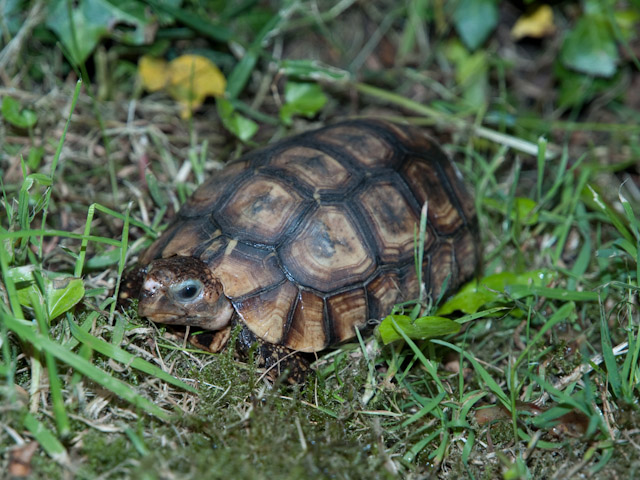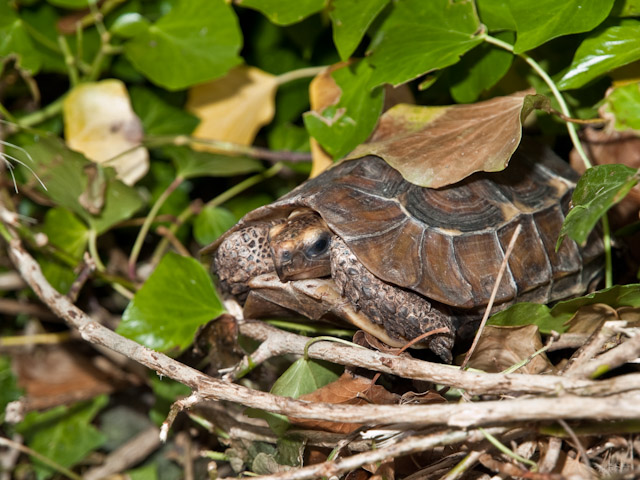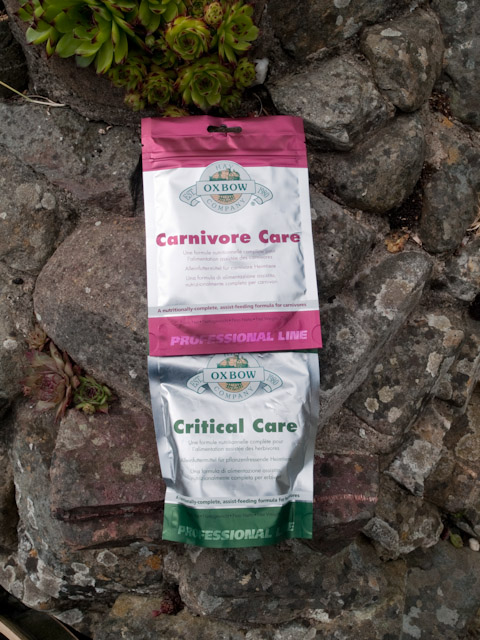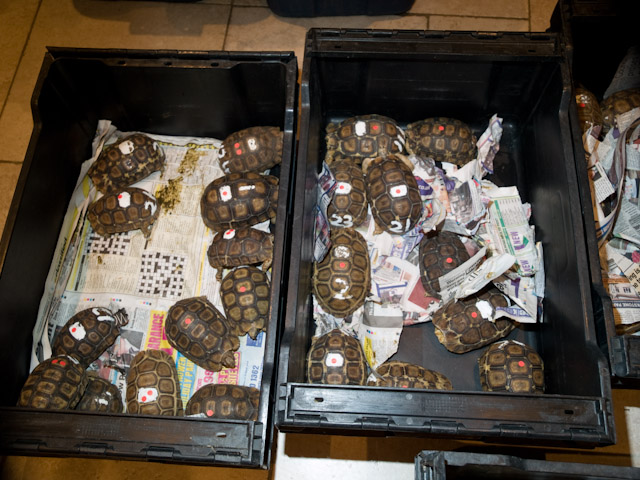
The
Rehabilitation
of
Hingeback
tortoises (Genus Kinixys)

Andy C.
Highfield
Hingeback tortoises (Genus Kinixys) have an unenviable reputation as “difficult” tortoises, particularly when newly imported. There are good reasons for this. To begin with, they undoubtedly stress easily, they have very specific requirements in terms not only of temperature, but also of light level and ambient humidity, and they are far from easy to handle and treat (more on this shortly). The most common set of problems encountered with these tortoises involve emaciation and high levels of intestinal parasites: not only helminths (worms) but also flagellate and ciliate protozoan organisms. It is these protozoans that are often implicated in the steady decline in health of new imports and, ultimately, in the deaths of many.
The pattern of symptoms that may be seen includes diarrhoea, the passage of mucus, sometimes containing traces of blood and undigested food particles,reluctance to feed , loss of weight, dehydration and general listlessness. A fresh faecal sample examined under the microscope will reveal very high concentrations of protozoans, particularly Trichomonas spp., Balantidium spp and Nyctotherus spp. Not all of the potentially responsible organisms are visible so readily, however, and it is important to be aware that other poentially pathogenic organisms such as Entamoeba invadens and Hexamita parva may also be present. At low levels these may not cause a problem, but at high concentrations they can be very damaging.
When these parasites reach high densities within the digestive or urinary tracts, the consequences can be severe: a condition known as amoebiasis develops that results in intestinal inflammation, erosion and perforation. If this occurs, life-threatening septicaemia may result very quickly. In addition, trophozoites may spread via the circulatory system to other major organs including the liver, lungs and spleen resulting in necrosis and abscessing. It is therefore very important that prompt action is taken to treat the condition before irreversible deterioration occurs.
The first stage when confronted by recently imported, sick, hingeback tortoises is to stabilise their condition as quickly as possible, without adding further stress. Initially, this is best achieved by restoring hydration status. In many cases, Hingeback tortoises respond well to very extended ‘soak’s in shallow, tepid water. Forest hingebacks in particular seem to benefit from this. We have found that placing them in a large plastic container with about 15 to 20 mm depth of water with added Diroralyte, and with a heat pad beneath can be highly effective at encouraging them to drink and rehydrate voluntarily. We will often leave them like this for 8-12 hours at a time. Placing a partial plastic cover over the top of the container also serves to raise ambient humidity to 85% or more within the unit. Keeping light levels low, with humidity in the 85%+ range, with temperatures at about 28 Celsius quickly stabilised a small group of badly dehydrated Kinixys erosa and Kinixys homeana.

After several hours of soaking, the by-now soiled water is removed and the tortoises are transferred to a second, identical unit with only a couple of mm depth of water. The contaminated unit is then disinfected by prolonged exposure to Virkon-S at a dilution of 1:100 before being thoroughly rinsed before the next use. Meanwhile, food is now offered on a plate (just out of the very shallow water) in the second unit. Red-coloured items such as over-ripe strawberry, tomatoes and other fruits such as banana and melon are typically accepted enthusiastically. Mushrooms are also well liked. In addition, this is sprinkled lightly with Oxbow Carnivore Care formula once a week (Hingeback tortoises are omnivores, taking snails and other invertebrates, as well as carrion in the wild). Green leaf matter, such as dandelion, chicory and mixed green salad items are also included and can often be taken in preference to the fruit.

Once initial hydration has been established, and the animals assessed, faecal samples are again analysed and treatment is given with Metronidazole in the form of Flagyl-S by stomach tube.Two doses are given, each at a rate of 100mg per Kg, 14 days apart. Hingebacks are challenging to tube, as they have a rather narrow aperture at the front between the carapace and plastron, and can withdraw their heads far back into the shell. It can be a time consuming (and sometimes frustrating!) process, particularly if a large number of tortoises are to be treated.
It is important to note that not all the parasites that may be implicated will respond positively to Metronidazole. Entamoema invadens, for example, may require further follow up treatment with Paromomycin (Humatin) or diiodohydroxyquin (Iodoquinal) if present in the gut lumen. In many cases, however, treatment with Metronidazole will serve to massively reduce the severity of the symptoms and will buy additional time for future more targeted therapies if required.

Throughout this process it is important to minimise stress, and give the animals own immune system and natural gut flora the best possible opportunity to recover. Keeping the tortoises at optimal temperature and humidity is believed to play a major role in this. Frequent soaking (as previously described) is absolutely critical. The restoration of normal gut function can also be aided by use of pro-biotic products: one specifically designed for reptiles is Nutri-Bac (Fowler’s Foods, Arizona). We tested this with the recent batch of 28 Kinixys belliana and Kinixys erosa and found that it did appear to help re-establish normal digestion following treatment with Metronidazole.
Following anything from 7 to 10 days in the type of environment described (alternating between deeper soaking water and shallower, clean units) the tortoises that are responding positively can be removed to large containers with a deep (15 cm) moist peat and bark mulch substrate. They will spend quite a lot of time buried in this, emerging to eat, usually early in the morning or later in the evening as light levels fall.
As the animals settled, the droppings became gradually more solid and healthy looking. The mass of parasites seen in earlier samples was massively reduced. They began putting on weight, and feeding daily. The lethargy and dehydration observed upon their arrival was no longer evident. The key to this seems to be to attack the parasite proliferation using metronidazole (and if necessary, other therapeutic agents such as Paromomycin), to concentrate on maintaining hydration and reducing stress, and to encourage the establishment of a healthy gut flora by means of diet and the use of pro-biotics.
It should be noted that some of the organisms that may be carried by recently imported Kinixys species are highly contagious, and also pose a threat to humans (e.g. Balantidium), or other tortoises or reptiles (e.g. E. invadens). It is therefore essential that great care is taken when handling, or when disposing of uneaten food or contaminated water or substrate. A rigourous cycle of disinfection must be followed at all times. It is a very good idea to monitor all imported hingeback tortoises carefully and regularly for at least 12 months, with particular attention directed at their weight, hydration and digestive tract health. Any deterioration should be dealt with immediately by taking faecal samples for microscopic analysis. Further treatments with metronidazole (or paromomycin) should be undertaken as necessary.
(c) 2010 Tortoise Trust